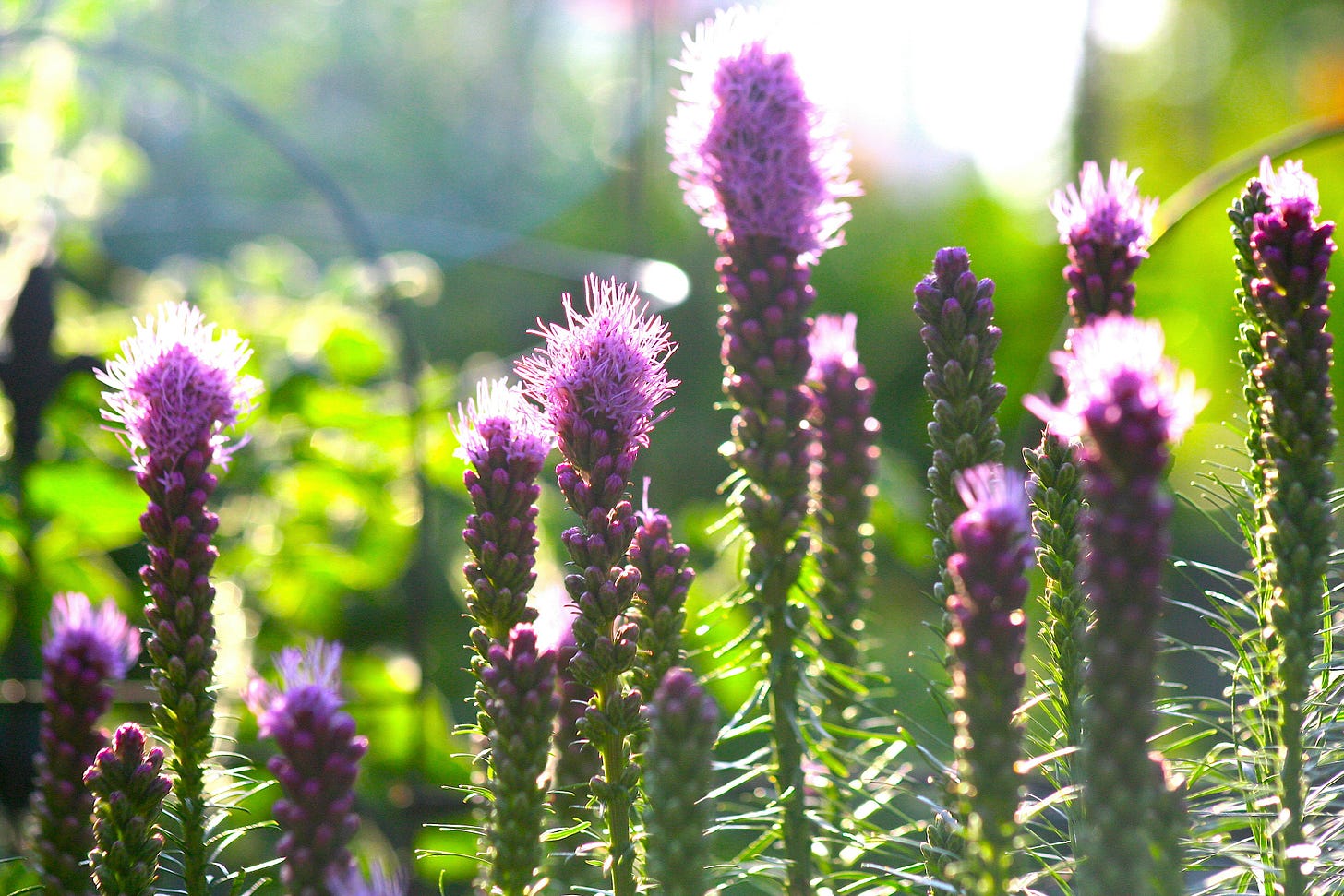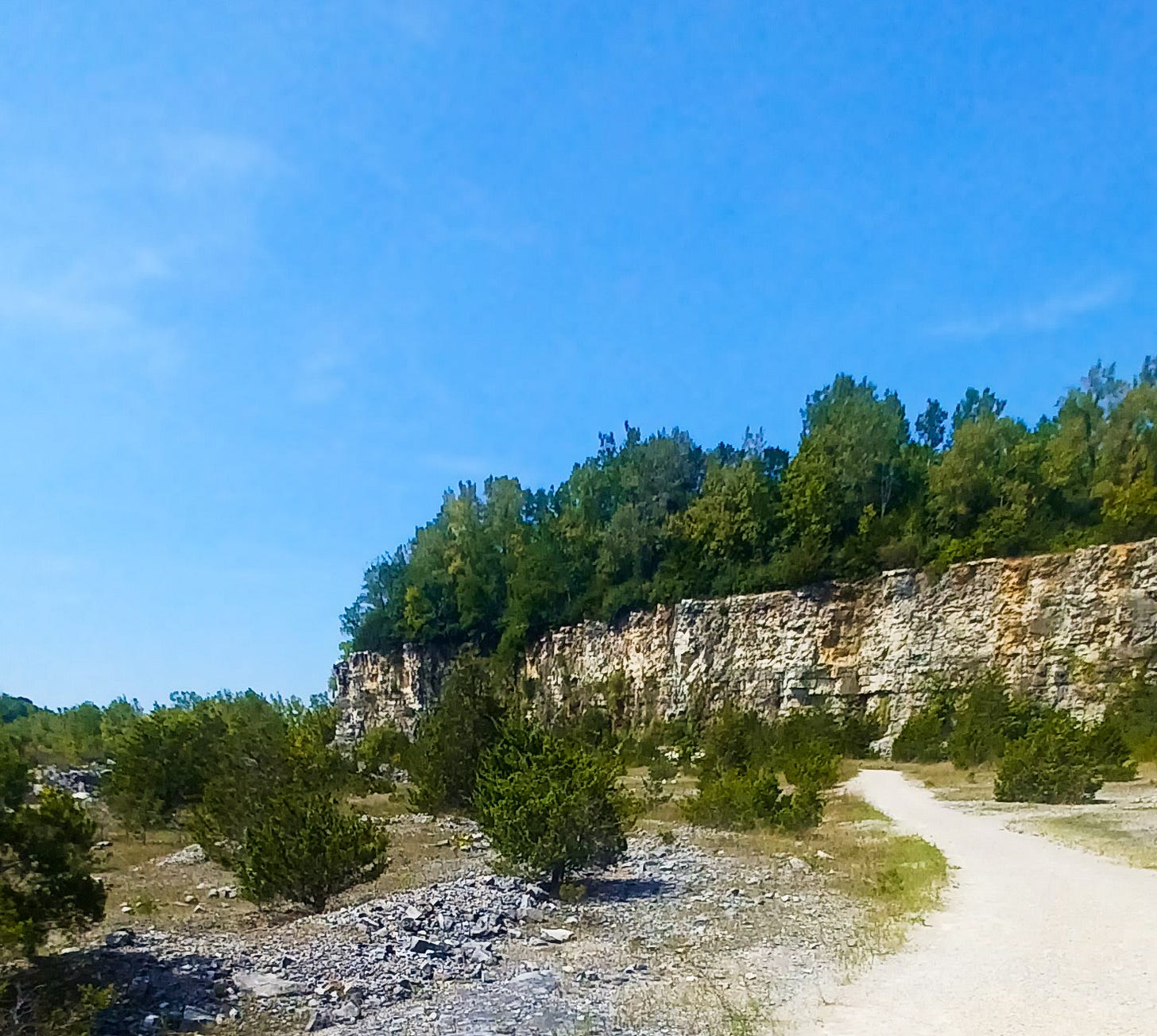The August sun beats down on the gray-white moon-like landscape with piles of rocks. Four turkey vultures circle overhead, which feels a bit unsettling, always. As I walk I am sloping from the rim of the old quarry down to its floor, the part of it that stays dry enough for a hiking trail to wind through. The brightness of the pale rock container, below and surrounding me, with the cloudless blue sky above, makes me feel a little like I am an ant on a sun reflector that a giant is using to get tan. The other side of the quarry seems to remain shallowly flooded, a vivid blue-green full of life for algae, fish, and the sycamores that grow out of little islands of limestone that peek above the surface.
For some sixty-odd years this quarry was part of the open pit limestone mining industry that Indiana is famous for - it is one of the side effects of a landscape chock-full of limestone deposits that make the caves I wrote about last time possible. Like many, this one closed in the late 70s, but it was adopted by the adjacent DePauw University in 2004 and turned into a community “green space” and living biological lab for its science students.
Open pit mining is considered to be one of the most ecologically devastating processes that can happen to a landscape. “Quarrying drastically destroys flora and fauna, thereby reducing biodiversity and disrupting fundamental ecological relationships. Moreover, it extensively damages soil by modifying the original site topography and depleting and altering soil microbial communities,” write the authors of a paper on evaluating ecological restoration in quarries, published in the journal Sustainability.1
It’s a point of pride for many who are from this area that Indiana limestone was used to build buildings like the Empire State Building and the Pentagon. People have been mining limestone for many millennia - the quarries in Egypt date back to the Old Kingdom (around 2700-2200 BC) and are designated as archaeological sites now. Limestone from the Cotswolds was used in a famous Neolithic long barrow tomb (built around 3650 BC) about 25 miles away, in what is now called England. For me, looking at this much more recently quarried landscape struggling to come back after nearly fifty years of re-growth, I am feeling into the choices that humans make at the level of a society - what we are willing to dig for, what kinds of materials feel necessary and for what purposes, what lengths we are willing to go for monuments to what that society holds in the highest esteem - the dead, the living rulers (future dead), commerce, or war.
Maybe you’ve seen Breaking Away, the “cult classic” movie from the 70s about the Little 500 bike race that takes place here in Bloomington every year, which features some incredible scenes in a flooded quarry, which the main characters frequent as a swimming hole, which you can see if you watch the first fifty seconds or so of this video. The real-life company that owns the quarry had to completely fill it in a few years ago because people wouldn’t stop diving in and getting horribly injured, or worse. When you watch those scenes in the film you can understand why they’d want to - it looks delicious. Finding pleasure and ease in the wastelands is its own reward.
The floor of the quarry I’ve come to is dusty, silty, with errant piles of limestone chunks everywhere. It appears to the naked eye completely inhospitable to life - it does not look anything like soil. But signs of life are everywhere - small juniper trees struggle out of the ground, stands of sycamore and phragmites clump together presumably in places where water is more likely to collect in rainier times. Goldenrod, boneset, and roughleaf dogwood grow together in patches along the trail as well - each looking a bit like it is staking out a claim in rough territory, which of course it is. What happened between 1977 and 2004 that made this possible, I wonder. I am so intrigued by these “wasteland” sites that don’t seem like they’d be of any use to restore - these seem to me to be places of potential that warrant a closer look.
Limestone is almost entirely calcium - like I mentioned last time it’s the remains of tiny creatures from the ancient sea that was here millions of years ago, so their shells, for example. Calcium is extremely important to have in your soil if you’re trying to grow plants because it makes up the majority of their carbon scaffolding - the bones of the plant, if you will. And calcium is considered a “limiting nutrient” in the soil because, again, it’s extremely necessary, and its presence or absence can help determine the health of your plants. It also leaches out of the soil pretty quickly due to its solubility in water, its ability to be dissolved. So you need it in there, but it’s hard to hold onto in the soil.2
The other problem with calcium in the soil is that plants can’t access it directly - they have to have a mycorrhizal fungi as an intermediary. This is a somewhat complicated dance of relationships that’s outside the scope of this particular missive, but basically the fungi and the plants exchange nutrients for sugars - the fungi regurgitates the nutrients in a form the plants can absorb, and this relationship helps them both grow. So the common wisdom is that the best way to keep calcium in your soil and available to your plants is to be continuously cycling organic matter as much as possible (decomposing leaves, compost, etc).
So, knowing this, it’s really wild looking at the trees and other plants growing on the floor of this old quarry which is, in theory, almost entirely calcium with almost no organic matter - there is no soil here, really, there is only limestone dust and chunks, all of it absolutely baking in the sun. But there are stands of junipers and sycamores3 over thirty feet tall - so what does that tell us? Even here, in soil that has been degraded in an extreme way, the fungi find a way, baby. And once these early succession plants get a foothold, over time they basically clear a path for later-succession plants to come in and have the right conditions to thrive.
In studying the fungal species found in old limestone quarry sites, Sansupa et al. found some results that astounded me. “Opencast limestone mines or limestone quarries are considered challenging ecosystems for soil fungi as they are highly degraded land with specific conditions, including high temperature, prolonged sunlight exposure, and a lack of organic matter, moisture, and nutrients in soil. In such ecosystems, certain fungi can survive and have a crucial function in maintaining soil ecosystem functions…The majority of fungi in these plots are classified as saprotrophs, which potentially produce all fifteen soil enzymes used as soil health indicators [emphasis mine - WOW]…due to the ability of fungi to take on numerous forms, they can successfully inhabit a variety of soil conditions, even the unfavorable. They can also function as ecological regulators, responsible for soil formation, rock weathering, or organic compound decomposition.”4
That study found fungi in their quarry test sites that basically function to make it possible for early succession plants to grow in extremely difficult conditions, like drought and other kinds of chemical stress. I hope I never stop feeling amazed about what fungi are quietly capable of, and about what we owe of our existence to them.
It makes me think of one of my favorite DIY scientist/artists, Candace Thompson and their project the C.U.R.B. - Collective Urban Resilience Banquet - whose work I have been following for many years now and deeply admire. Thompson’s family foraged and hunted much of their food when they were growing up, and when Thompson moved to NYC they always wondered about the plants (typically considered “weeds” but delicious and densely nutritious like dandelion, lamb’s quarter, peppergrass, among many others) thriving in the cracks in their neighborhood, which was near a Superfund site. They wondered how actually toxic these plants were compared to what you’d buy in the supermarket, and whether traditional preservation techniques like pickling, lacto-fermentation, and beer-brewing could make them less so. And HOO BOY are the results absolutely fascinating - if that sounds interesting to you I would suggest just reading their entire thesis (oh, another thing that is amazing about this whole project is that it’s for an interdisciplinary MFA, hybridizing disciplines in a truly inspirational way) which is freely available online, just plan to never look at supermarket lettuce (or weeds near the dump) the same way again.
I find this work to be extremely important and enlightening because it re-frames the way that we so commonly look at “nature” as something that’s “out” there, a destination that you have to get to, that’s in the park or the forest preserve or the hiking trail - and shows it to be, more accurately, something that is literally and irrepressibly growing through the cracks in our civilization. And it reveals those cracks - the “human wasteland” as Thompson calls it, the post-industrial sacrifice zone - to be sites of possibility for further investigation.
This is not to say, obviously, that nature is resilient so we can fuck it up as much as we want and just make pickles later - NO (and that’s certainly not what Thompson is saying either). Rather, as we see climate crisis accelerate alongside the attendant poisons that constitute our economy and lifeways, we can shift the frame from despair to curiosity and that maybe, dare I say it, something like hope lives there.
Thanks for reading! I love to write these newsletters, but I’m also a garden designer by trade. Fall is coming, which is my favorite time to plant perennials, so just a friendly reminder that if you live in the Midwest I have created a DIY planting guide for anyone wanting to add some low-maintenance, high-beauty native plants to their landscape, but who maybe isn’t quite sure where to start. It’s fifteen plants with eight pages packed with planning, planting, and tending information. Check it out and feel free to respond to this email if you have any questions for me.

You can read the full text for free here: https://www.mdpi.com/2071-1050/10/3/619
You also need a small amount of Boron, which is basically the “key” (called an enzyme co-factor in science-speak) to unlocking calcium absorption in plants. Don’t sleep on those micronutrients, y’all!
Through researching for this newsletter I learned that sycamores are a common tree that re-vegetates former coal mines all across the Midwest. “[I]t is sometimes found in excellently stocked natural stands on coal-stripped land of the Central States. In Missouri, too, sycamore is often found in pure stands or in mixture with other hardwoods that volunteer on spoil banks, and it is one of the pioneer species on the ridges of strip-mined land in Vermillion County, IL.” [source]
You can read the full text for free here: https://www.ncbi.nlm.nih.gov/pmc/articles/PMC9604801/








This whole essay slaps but that footnote on sycamores just inspired 5 pages of writing so big ups to you bud 🫡🫡🫡
Adored this edition! Huzzah for nerding out on fungi facts